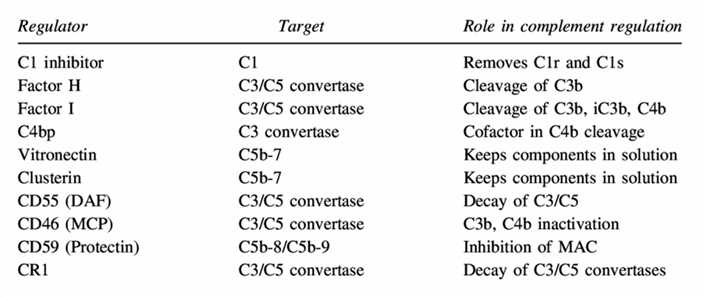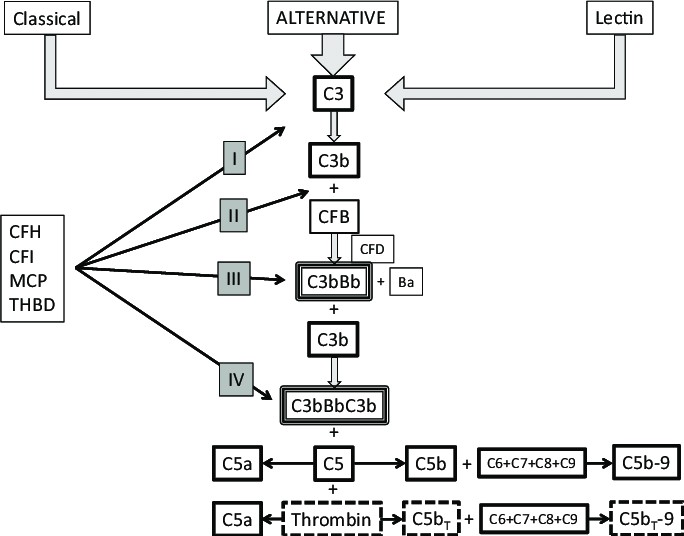Complement Regulatory Proteins
Related Symbol Search List
- TFPI2
- F2
- F7
- Protein C
- PROCR
- PROS1
- Protein S
- C5
- C9
- CFH
- CFHR5
- CFB
- ADORA2A
- ADTRP
- ANXA4
- ANXA8
- CD46
- CFHR1
- CFHR2
- CPB1
- F2R
- F8
- Lcn2
- LRRC3B
- SAA1
- THBS1
- VSTM2L
Immunology Background
About Complement Regulatory Proteins
Complement regulatory proteins are a group of proteins that play a crucial role in the regulation of the complement system (which is a part of the immune system), and are primarily involved in controlling the activation, amplification, and termination of the complement cascade. The complement system is a cascade of proteins and molecules that can be activated in response to immune challenges, such as infections or tissue damage.
Examples of complement regulatory proteins include complement factor H (CFH) , complement factor I (CFI), decay-accelerating factor (DAF), membrane cofactor protein (MCP), CD46 , and CD59. These complement regulatory proteins, along with others, work in a coordinated manner to prevent excessive complement activation, protect self-cells, and maintain immune balance. Through their regulatory functions, they help prevent immune attacks on healthy tissues while effectively eliminating pathogens and immune complexes.
Deficiencies or dysregulation of complement regulatory proteins can lead to complement-mediated diseases, such as atypical hemolytic uremic syndrome (aHUS), paroxysmal nocturnal hemoglobinuria (PNH), and age-related macular degeneration (AMD). Understanding the roles and mechanisms of complement regulatory proteins is important for unraveling the pathogenesis of complement-related disorders and developing targeted therapies to modulate complement activity.
Table 1 Complement Regulatory Proteins. (Cummings KL, et al., 2007)

Physiological Functions of Complement Regulatory Proteins
Protection of Self-Cells: One of the main functions of complement regulatory proteins is to protect self-cells from complement-mediated damage. They prevent the excessive or inappropriate activation of the complement system in healthy cells, reducing the risk of complement-mediated tissue injury.
Regulation of Complement Activation: Complement regulatory proteins control the activation and amplification of the complement cascade at various stages. They inhibit the formation and accelerate the decay of complement enzymatic complexes, such as C3 and C5 convertases, which are responsible for propagating the complement cascade. By regulating these complexes, complement regulatory proteins help maintain a balanced and controlled complement response.
Decay and Clearance of Complement Components: Complement regulatory proteins facilitate the decay and clearance of complement components, preventing their accumulation and maintaining immune homeostasis. They enhance the degradation of activated complement proteins, such as C3b and C4b, by factors such as factor I, preventing their prolonged activity and reducing the risk of complement-mediated tissue damage.
Protection against Membrane Attack Complex (MAC) Formation: Complement regulatory proteins, such as CD59 (Protectin), inhibit the assembly and formation of the membrane attack complex (MAC). The MAC is the final step of the complement cascade and can cause cell lysis. By preventing MAC formation, complement regulatory proteins protect self-cells from complement-mediated destruction.
Modulation of Inflammatory Response: Complement regulatory proteins help modulate the inflammatory response associated with complement activation. Excessive complement activation can lead to an exaggerated immune response and tissue inflammation. By regulating the complement cascade, these proteins contribute to the fine-tuning of the inflammatory process, preventing excessive inflammation and maintaining immune balance.
Prevention of Autoimmunity: Complement regulatory proteins protect self-tissues from complement attack and help prevent the recognition and destruction of self-cells by the immune system. Dysregulation or deficiencies of complement regulatory proteins can lead to the breakdown of self-tolerance and the development of autoimmune disorders.
Overall, complement regulatory proteins are essential for maintaining the delicate balance of the complement system. They protect host tissues, regulate complement activation, prevent excessive inflammation, and contribute to immune homeostasis. Dysfunction or deficiencies in these regulatory proteins can have significant implications for immune health and may contribute to the development of complement-mediated diseases.
 Fig. 1 Complement cascade and complement regulatory proteins (CRP). (Berger BE, 2018)
Fig. 1 Complement cascade and complement regulatory proteins (CRP). (Berger BE, 2018)
Available Resources for Complement Regulatory Proteins
Creative BioMart is committed to providing scientific researchers with a wide range of products and personalized services related to complement regulatory proteins. At the same time, we have also assembled extensive resources on complement regulatory proteins, including involved pathways, protein functions, interacting proteins, related articles, research areas, and related topics. Whether you are interested in the pathways and regulatory mechanisms of complement regulatory proteins or want to understand their functions and roles in different biological processes, we can meet your needs.
Our goal is to provide scientific researchers with a one-stop solution to help them deeply understand the mechanism of complement regulatory proteins and contribute to research in related fields. Welcome to Creative BioMart, where we can jointly advance research on complement regulatory proteins through our rich resources and personalized services.
Our Featured Products
- Recombinant Human CD46 protein, His-tagged
- Recombinant Human CFH, His tagged
- Recombinant Human CFB, GST-tagged
- Recombinant Human THBS1 protein, His-tagged
- Recombinant Human SAA1, GST-tagged
- Recombinant Human SAA1 protein, His-tagged
- Recombinant Human LRRC3B, GST-tagged
- Recombinant Human LCN2 protein, His-tagged
- Recombinant Human LCN2, His tagged
- Human Factor-VIII
- Recombinant Human Coagulation Factor VIII, Procoagulant Component
- Recombinant Human F8, His-tagged
- Recombinant Human F2R protein, His-tagged
- Active Recombinant Mouse Cpb1 protein, His-tagged
- Active Recombinant Rat Carboxypeptidase B1 (tissue)
- Recombinant Human CFHR1 protein, GST-tagged
- Recombinant Human ANXA4, GST-tagged
- Recombinant Human C9, GST-tagged
- Recombinant Human F2 Protein, His-tagged
- Recombinant Mouse F2, His tagged
- Recombinant Human TFPI2, His tagged
If you have any questions, requirements, or cooperation intentions, please feel free to contact us. We very much look forward to working with you and helping you achieve research and commercial success.
References:
- Cummings KL, Waggoner SN, Tacke R, Hahn YS. Role of complement in immune regulation and its exploitation by virus. Viral Immunol. 2007;20(4):505-524.
- Berger BE. Atypical hemolytic uremic syndrome: a syndrome in need of clarity. Clin Kidney J. 2018;12(3):338-347.

